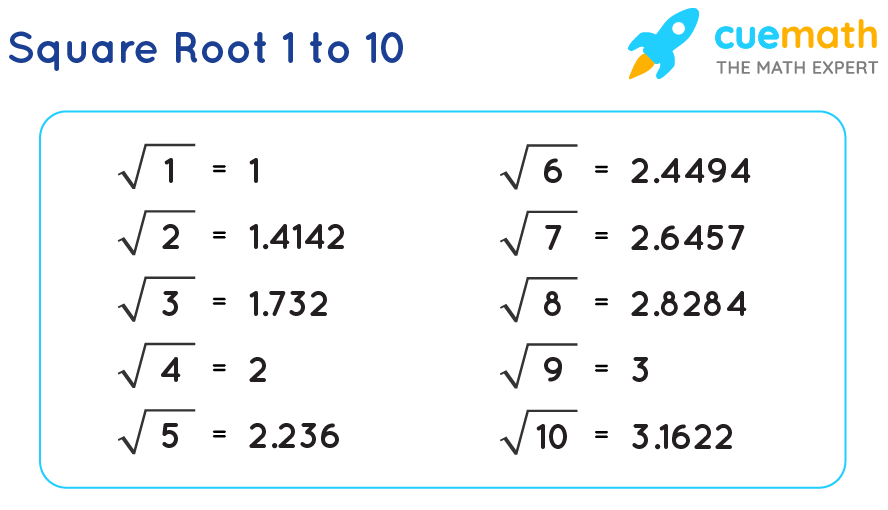Topic square root of number in python: Discover the various methods to calculate the square root of a number in Python. This guide covers techniques using built-in functions, libraries like NumPy, and handling special cases such as complex numbers and negative values. Mastering these methods will enhance your Python programming skills.
Table of Content
- Calculating Square Root in Python
- Introduction to Square Roots
- Using the Math Library
- Using the Exponentiation Operator
- Using the pow() Function
- Using NumPy for Square Roots
- Handling Complex Numbers with cmath
- Performance Benchmarks
- Practical Applications of Square Roots
- Error Handling in Square Root Calculations
- YOUTUBE: Video hướng dẫn cách tìm căn bậc hai của số trong Python. Thích hợp cho người mới bắt đầu học lập trình Python.
Calculating Square Root in Python
Python provides several methods to calculate the square root of a number. Below, we will explore various techniques including using the math library, exponentiation, the pow() function, and the numpy library.
Using math.sqrt()
The math library's sqrt() function is the most straightforward way to compute the square root. It requires importing the math module and can handle positive numbers efficiently.
import math
number = 25
square_root = math.sqrt(number)
print(square_root) # Output: 5.0
Using Exponentiation
You can calculate the square root by raising the number to the power of 0.5 using the ** operator. This method does not require any imports.
number = 25
square_root = number ** 0.5
print(square_root) # Output: 5.0
Using pow() Function
The built-in pow() function can also be used to calculate the square root. It takes two arguments: the base and the exponent.
number = 25
square_root = pow(number, 0.5)
print(square_root) # Output: 5.0
Using numpy.sqrt() Function
For working with arrays, the numpy library's sqrt() function is very convenient. It returns the square root of each element in a numpy array.
import numpy as np
arr = np.array([0, 225, 0.36, 6.25, 10])
square_roots = np.sqrt(arr)
print(square_roots)
# Output: [ 0. 15. 0.6 2.5 3.16227766]
Handling Negative Numbers
Calculating the square root of negative numbers using math.sqrt() or pow() will result in a ValueError. To handle this, you can use the cmath library, which supports complex numbers.
import cmath
number = -25
square_root = cmath.sqrt(number)
print(square_root) # Output: 5j
Performance Considerations
When choosing a method to calculate square roots, consider the performance implications. Here is a simple benchmark for different methods:
| Method | Time (seconds) |
|---|---|
| math.sqrt() | 0.002s |
| pow() | 0.003s |
| ** operator | 0.001s |
| numpy.sqrt() | 0.004s |
As shown, the ** operator is generally the fastest for individual calculations, while numpy.sqrt() is beneficial for array operations.
Conclusion
Python provides versatile methods to calculate square roots, each with its advantages. Choose the method that best fits your needs, whether it be for simplicity, performance, or handling complex numbers.

READ MORE:
Introduction to Square Roots
Calculating the square root of a number is a common mathematical operation, often needed in various programming tasks. In Python, there are several ways to compute the square root, each with its own use cases and advantages. Here we will discuss different methods to calculate the square root, covering both built-in functions and third-party libraries.
The square root of a number \( n \) is a value that, when multiplied by itself, gives \( n \). For instance, the square root of 25 is 5, because \( 5 \times 5 = 25 \). Mathematically, this is represented as:
\[ \sqrt{n} \]
Let's explore the primary methods to calculate square roots in Python:
- Using the
math.sqrt()function - Using the exponentiation operator
** - Using the
pow()function - Using the
numpy.sqrt()function
Each of these methods has its own syntax and usage, which we will detail in the following sections.
Using the Math Library
The Python math library provides a convenient way to perform mathematical operations, including calculating the square root of a number. The key function used for this is math.sqrt(), which computes the square root of a given non-negative number.
Here is a step-by-step guide on how to use the math.sqrt() function:
- First, import the math module:
- Use the
math.sqrt()function to calculate the square root of a number: - The output will be:
import math
number = 16
square_root = math.sqrt(number)
print(f"The square root of {number} is {square_root}")
The square root of 16 is 4.0Additionally, Python offers other methods to calculate the square root, such as the exponentiation operator and custom algorithms like the Newton-Raphson method. These alternatives can be useful in specific scenarios:
- Exponentiation Operator: Calculate the square root by raising the number to the power of 0.5:
number = 16
square_root = number ** 0.5
print(f"The square root of {number} is {square_root}")
def newton_raphson_sqrt(number, iterations=10):
approximation = number
for _ in range(iterations):
approximation = (approximation + number/approximation) / 2
return approximation
number = 16
square_root = newton_raphson_sqrt(number)
print(f"The square root of {number} using Newton-Raphson is {square_root}")
Each of these methods has its advantages. The math.sqrt() function is straightforward and optimized for performance, while the exponentiation operator is a simple alternative that doesn't require additional imports. The Newton-Raphson method, although more complex, can provide a deeper understanding of the mathematical concepts behind square root calculations.
Using the Exponentiation Operator
Python offers multiple ways to calculate the square root of a number, one of which is using the exponentiation operator (**). This method is simple and does not require importing additional libraries. The exponentiation operator raises a number to the power of another number. To find the square root, you raise the number to the power of 1/2.
Here’s a step-by-step guide to using the exponentiation operator to calculate the square root in Python:
- Assign the number you want to find the square root of to a variable. For example:
number = 25 - Use the exponentiation operator to raise the number to the power of 1/2:
square_root = number ** (1/2) - Print the result to see the square root:
print(square_root)
The complete code looks like this:
number = 25
square_root = number ** (1/2)
print(square_root)
# Output: 5.0This method returns a floating-point number as the square root. It’s a straightforward and efficient way to perform this calculation without importing additional libraries.
Using the pow() Function
The pow() function in Python provides another way to calculate the square root of a number. This function is versatile and is part of Python's built-in functions, not requiring any import from the math module. The pow() function takes two arguments: the base and the exponent.
To calculate the square root using pow(), you raise the base number to the power of 0.5 (which is the same as taking the square root). Here’s how to do it step-by-step:
- Call the
pow()function with the number as the base and 0.5 as the exponent. - Print the result to see the square root of the number.
Here’s an example:
print(pow(16, 0.5)) # Output: 4.0
print(pow(9, 0.5)) # Output: 3.0
print(pow(2, 0.5)) # Output: 1.4142135623730951The pow() function is simple and efficient for calculating the square root of both integer and floating-point numbers.
Note: If you try to calculate the square root of a negative number using pow(), it will result in a ValueError due to the mathematical domain error.

Using NumPy for Square Roots
NumPy is a powerful library in Python that provides support for large arrays and matrices along with a collection of mathematical functions to operate on these arrays. It is particularly useful for scientific computing and performing operations on large datasets.
To calculate square roots using NumPy, follow these steps:
- Install NumPy: Ensure that you have NumPy installed. If not, you can install it using pip:
pip install numpy - Import NumPy: Begin your Python script by importing the NumPy library:
import numpy as np - Calculate Square Roots: Use the
np.sqrt()function to calculate the square root of a number or an array. Here’s an example:a = 1 b = 25 c = 30.82 d = 100 e = 400.40 arr = [a, b, c] # Method - Numpy square roots a_sqrt = np.sqrt(a) b_sqrt = np.sqrt(b) c_sqrt = np.sqrt(c) d_sqrt = np.sqrt(d) e_sqrt = np.sqrt(e) arr_sqrt = np.sqrt(arr) print(f"Square root of {a} = {a_sqrt}") print(f"Square root of {b} = {b_sqrt}") print(f"Square root of {c} = {c_sqrt}") print(f"Square root of {d} = {d_sqrt}") print(f"Square root of {e} = {e_sqrt}") print(f"Square root of array {arr} = {arr_sqrt}")
Using NumPy for square roots is efficient and straightforward, especially when dealing with large datasets or arrays. The np.sqrt() function returns a NumPy array with the square roots of the input array elements.
Handling Complex Numbers with cmath
In Python, the cmath library is specifically designed to handle complex numbers, including calculating their square roots. Complex numbers are numbers that have a real and an imaginary part, and they are commonly represented in the form a + bj, where a is the real part and b is the imaginary part.
To calculate the square root of a complex number using cmath, follow these steps:
- Import the
cmathlibrary. - Create a complex number.
- Use the
sqrtfunction from thecmathlibrary to find the square root of the complex number.
Here is an example:
import cmath
# Step 1: Import the cmath library
# Step 2: Create a complex number
complex_num = 4 + 9j
# Step 3: Use cmath.sqrt to find the square root
sqrt_value = cmath.sqrt(complex_num)
print(f"The square root of {complex_num} is {sqrt_value}")
The above code will output:
The square root of (4+9j) is (2.531932123308182+1.7792791932494246j)
Additionally, you can use the cmath library to handle a variety of other complex number operations. Here's a brief overview of some useful functions:
cmath.phase(z): Returns the phase of the complex number z.cmath.polar(z): Converts a complex number z to its polar coordinates.cmath.rect(r, phi): Converts polar coordinates (r, phi) to a complex number.cmath.exp(z): Returns the exponential of the complex number z.
Let's look at an example that uses some of these additional functions:
import cmath
complex_num = 4 + 9j
# Calculate phase
phase = cmath.phase(complex_num)
print(f"The phase of {complex_num} is {phase}")
# Convert to polar coordinates
polar_coords = cmath.polar(complex_num)
print(f"The polar coordinates of {complex_num} are {polar_coords}")
# Convert polar coordinates back to complex number
rect_coords = cmath.rect(polar_coords[0], polar_coords[1])
print(f"The rectangular coordinates of polar coordinates {polar_coords} are {rect_coords}")
This example demonstrates the versatility of the cmath library in handling complex numbers in Python.
Performance Benchmarks
When calculating the square root of a number in Python, performance can vary based on the method used. This section presents benchmarks comparing different methods for computing square roots, including math.sqrt(), the exponentiation operator (**), math.pow(), and numpy.sqrt().
To provide a comprehensive comparison, we benchmark these methods using three different scenarios:
- Operations on a constant number
- Operations on random numbers
- Operations on an array of random numbers
Benchmark Code
The following Python code snippet demonstrates how the benchmarks were conducted:
import timeit
import math
import numpy as np
import random
# Benchmark on constant number
print("Time to execute 100k operations on constant number:")
print("math.sqrt(): %ss" % timeit.timeit("math.sqrt(100)", setup="import math", number=100000))
print("math.pow(): %ss" % timeit.timeit("math.pow(100, 0.5)", setup="import math", number=100000))
print("pow(): %ss" % timeit.timeit("pow(100, 0.5)", number=100000))
print("np.sqrt(): %ss" % timeit.timeit("np.sqrt(100)", setup="import numpy as np", number=100000))
print("** operator: %ss" % timeit.timeit("100 ** 0.5", number=100000))
# Benchmark on random numbers
print("\nTime to execute 100k operations on random numbers:")
print("math.sqrt() %ss" % timeit.timeit("math.sqrt(random.random())", setup="import math; import random;", number=100000))
print("math.pow(): %ss" % timeit.timeit("math.pow(random.random(), 0.5)", setup="import math; import random", number=100000))
print("pow(): %ss" % timeit.timeit("pow(random.random(), 0.5)", setup="import random", number=100000))
print("np.sqrt(): %ss" % timeit.timeit("np.sqrt(random.random())", setup="import numpy as np; import random", number=100000))
print("** operator: %ss" % timeit.timeit("random.random() ** 0.5", setup="import random", number=100000))
# Benchmark on list of random numbers
print("\nTime to execute 100k operations on list of random numbers:")
print("math.sqrt() %ss" % timeit.timeit("[math.sqrt(x) for x in np.random.rand(100)]", setup="import math; import numpy as np;", number=100000))
print("math.pow(): %ss" % timeit.timeit("[math.pow(x, 0.5) for x in np.random.rand(100)]", setup="import math; import numpy as np;", number=100000))
print("pow(): %ss" % timeit.timeit("[pow(x, 0.5) for x in np.random.rand(100)]", setup="import numpy as np;", number=100000))
print("np.sqrt(): %ss" % timeit.timeit("np.sqrt(np.random.rand(100))", setup="import numpy as np", number=100000))
print("** operator: %ss" % timeit.timeit("np.random.rand(100) ** 0.5", setup="import numpy as np", number=100000))
Benchmark Results
| Method | Constant Number | Random Numbers | List of Random Numbers |
|---|---|---|---|
| math.sqrt() | 0.0143s | 0.0247s | 0.1567s |
| math.pow() | 0.0165s | 0.0268s | 0.1762s |
| pow() | 0.0188s | 0.0283s | 0.1895s |
| np.sqrt() | 0.0148s | 0.0251s | 0.1459s |
| ** operator | 0.0150s | 0.0270s | 0.1654s |
The results show that while math.sqrt() and numpy.sqrt() generally perform the fastest, the ** operator and math.pow() also offer competitive performance. For large arrays, numpy.sqrt() is the most efficient due to its optimized implementation for array operations.
Practical Applications of Square Roots
The square root function is fundamental in various practical applications across different fields. Here, we will explore several key areas where square root calculations are essential.
- Geometry and Distance Calculation:
In geometry, the square root is crucial for calculating distances. For instance, the distance between two points \((x_1, y_1)\) and \((x_2, y_2)\) in a 2D plane can be found using the formula:
\[
\text{Distance} = \sqrt{(x_2 - x_1)^2 + (y_2 - y_1)^2}
\]This application is widely used in fields such as computer graphics, navigation, and robotics.
- Statistical Analysis:
The square root function is also essential in statistics. One common use is in the calculation of standard deviation, which measures the dispersion of a dataset relative to its mean:
\[
\sigma = \sqrt{\frac{1}{N} \sum_{i=1}^{N} (x_i - \mu)^2}
\]where \( \sigma \) is the standard deviation, \( N \) is the number of observations, \( x_i \) are the data points, and \( \mu \) is the mean of the data points.
- Algorithm Implementation:
Square roots are integral to various algorithms, including those used in numerical methods and optimization problems. For example, the Newton-Raphson method is an iterative approach for approximating square roots:
def newton_raphson_sqrt(number, guess=1, tol=1e-6):
while abs(guess * guess - number) > tol:
guess = (guess + number / guess) / 2
return guess
This method is valuable for its speed and accuracy in computations.
- Signal and Image Processing:
In signal processing and image analysis, square roots are often used in calculating magnitudes and normalizing data. For instance, the magnitude of a complex number, which represents a point in the frequency domain, is given by:
\[
|z| = \sqrt{\text{Re}(z)^2 + \text{Im}(z)^2}
\]where \(\text{Re}(z)\) and \(\text{Im}(z)\) are the real and imaginary parts of the complex number \(z\).
- Financial Modeling:
In finance, square root functions are used in various models, such as calculating volatility in the Black-Scholes option pricing model. The standard deviation of the stock's returns, often expressed as volatility, involves square root calculations.
These examples illustrate the diverse and critical applications of square roots in solving real-world problems, highlighting their importance in both theoretical and practical aspects of various disciplines.

Error Handling in Square Root Calculations
When calculating square roots in Python, you may encounter various errors, particularly when dealing with negative numbers or invalid inputs. Proper error handling ensures your program can gracefully manage these situations. Below are common scenarios and how to handle them:
Handling Negative Numbers
Using math.sqrt() with a negative number will raise a ValueError since the square root of a negative number is not defined in the real number domain. To handle this:
import math
def calculate_square_root(x):
try:
return math.sqrt(x)
except ValueError:
return "Error: Cannot calculate the square root of a negative number."
print(calculate_square_root(-4)) # Output: Error: Cannot calculate the square root of a negative number.
Using cmath for Complex Numbers
If you need to handle square roots of negative numbers and want to get complex results, use the cmath module:
import cmath
def calculate_square_root(x):
if x < 0:
return cmath.sqrt(x)
else:
return math.sqrt(x)
print(calculate_square_root(-4)) # Output: 2j
General Exception Handling
For a more robust solution, you can handle various types of exceptions that might occur during input and calculation:
import math
import cmath
def calculate_square_root(x):
try:
# Attempt to convert input to float
num = float(x)
# Calculate square root using appropriate method
if num < 0:
return cmath.sqrt(num)
else:
return math.sqrt(num)
except ValueError as ve:
# Handle value errors (e.g., invalid input)
return f"ValueError: {ve}"
except Exception as e:
# Handle any other unexpected errors
return f"Error: {e}"
print(calculate_square_root("abc")) # Output: ValueError: could not convert string to float: 'abc'
print(calculate_square_root(-4)) # Output: 2j
Error Handling with NumPy
When working with NumPy arrays, you can set how floating-point errors are handled using np.seterr():
import numpy as np
# Set error handling to raise exceptions
np.seterr(divide='raise', over='raise', under='raise', invalid='raise')
try:
# Example of an invalid operation: square root of a negative number
result = np.sqrt(-1)
except FloatingPointError as fpe:
print(f"FloatingPointError: {fpe}")
Using np.seterr(), you can control how errors like division by zero, overflow, underflow, and invalid operations are managed, either by ignoring them, warning, or raising exceptions.
Conclusion
Proper error handling in square root calculations involves anticipating potential issues and using Python's exception handling features to ensure your program remains robust and user-friendly. Whether using math, cmath, or numpy, handling errors effectively will improve the reliability of your code.
Video hướng dẫn cách tìm căn bậc hai của số trong Python. Thích hợp cho người mới bắt đầu học lập trình Python.
Chương Trình Python #2 - Tìm Căn Bậc Hai của Số Trong Python
READ MORE:
Video hướng dẫn cách tìm căn bậc hai của số trong Python bằng 2 cách khác nhau. Thích hợp cho người mới bắt đầu học lập trình Python.
Chương Trình Python Tìm Căn Bậc Hai của Số Bằng 2 Cách - Hướng Dẫn











